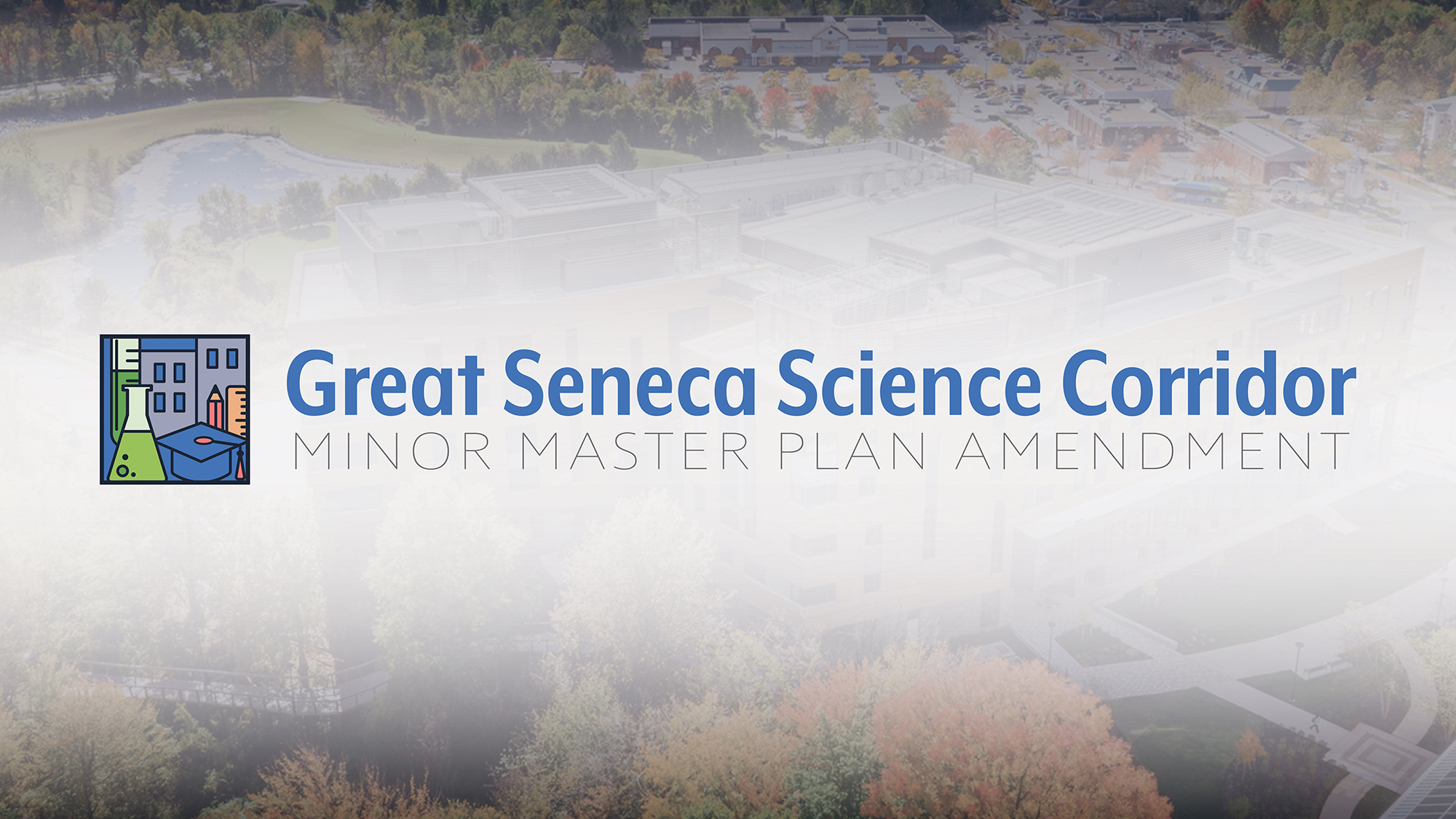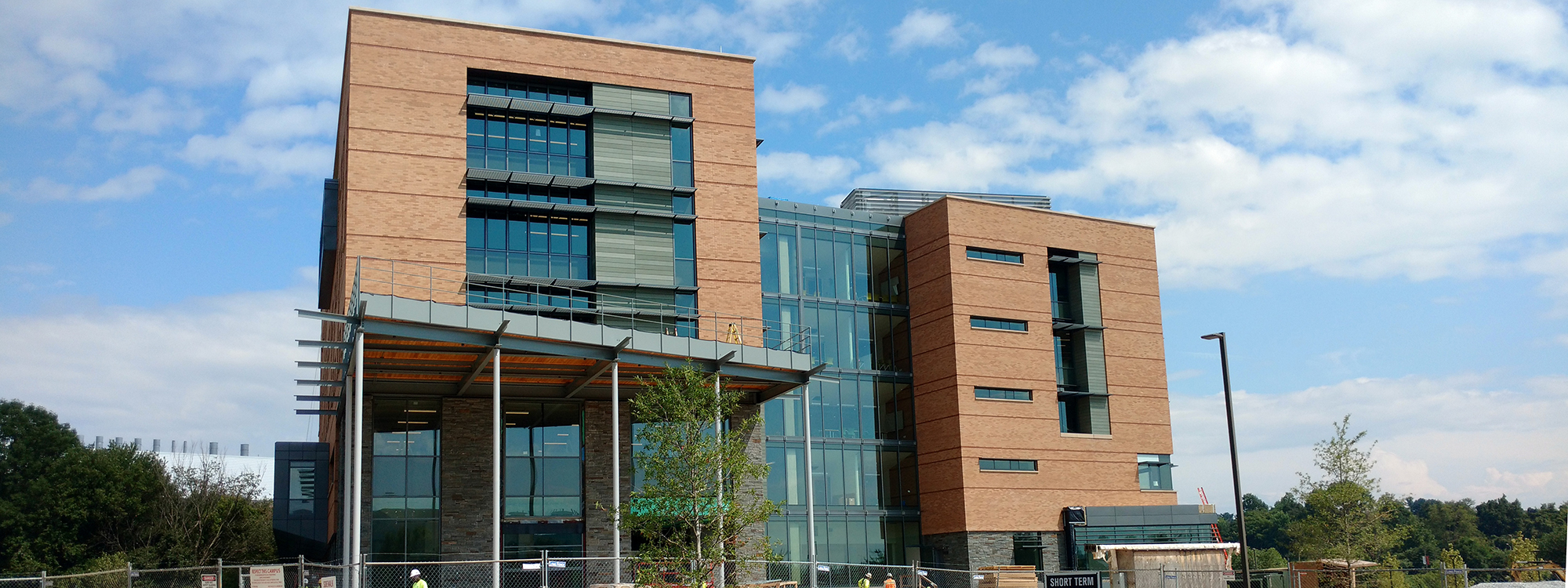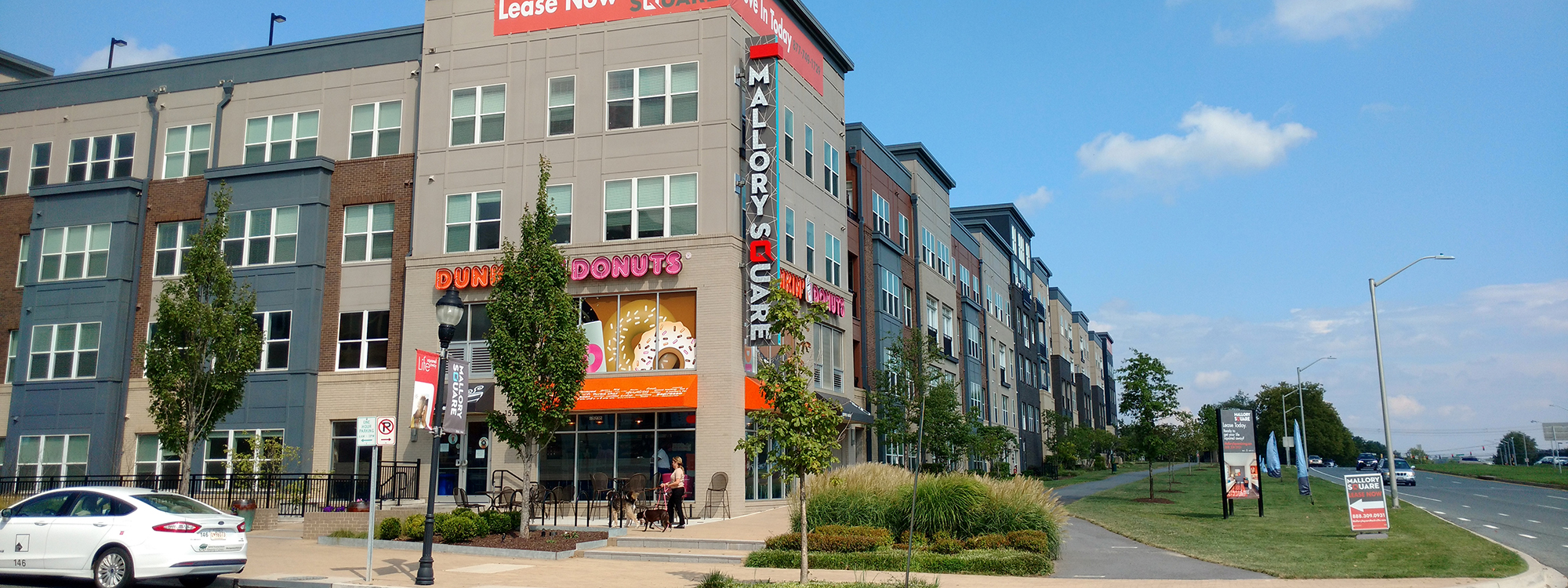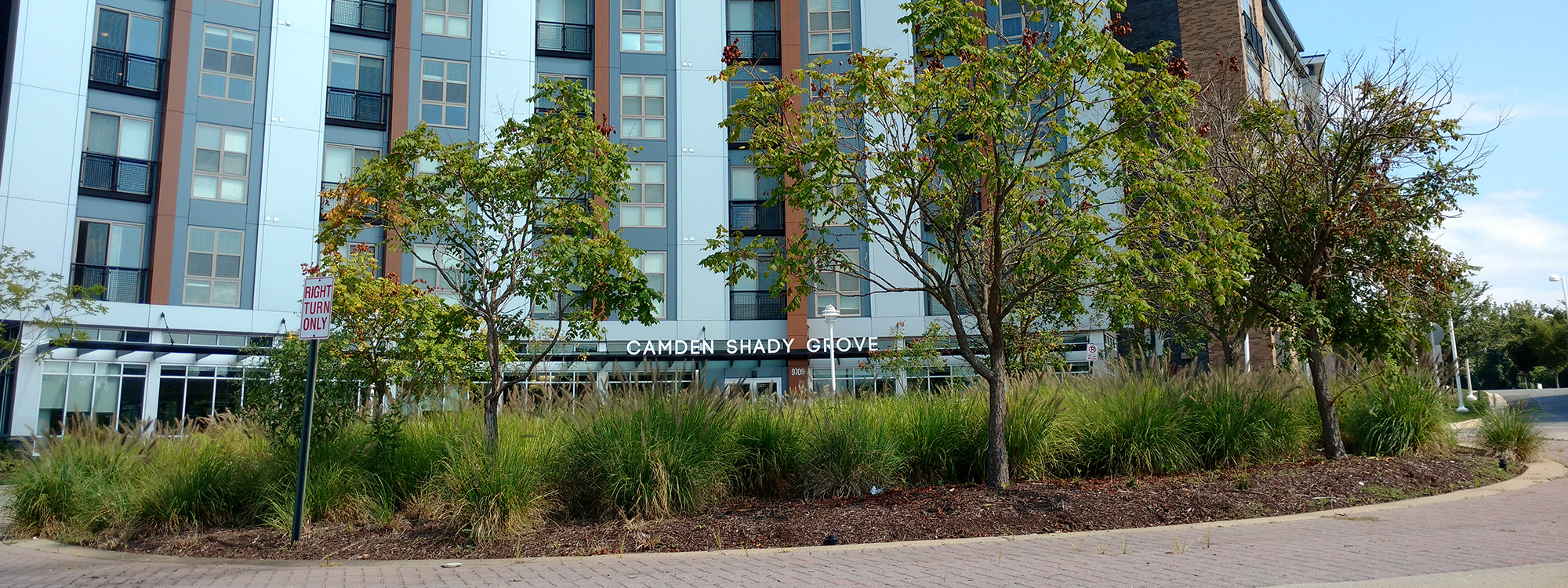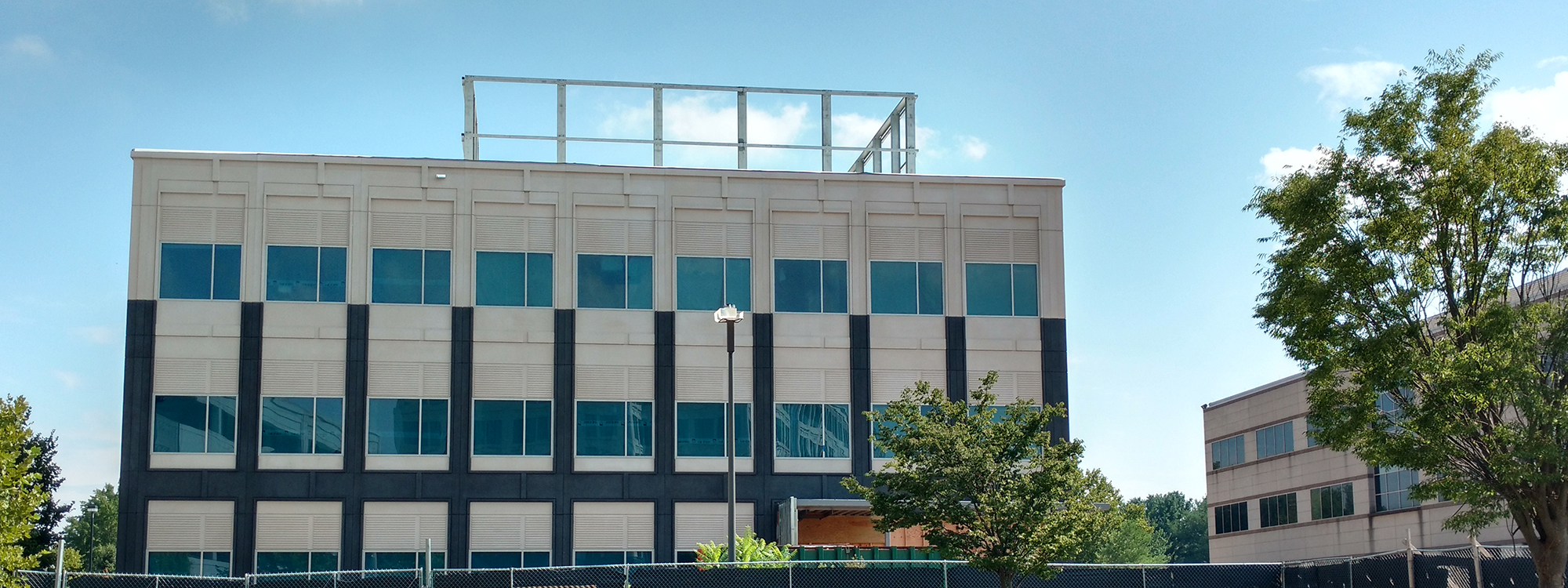The 2010 Great Seneca Science Corridor Master Plan (2010 Plan) created a vision for a dynamic live/work community that would support a globally recognized biotechnology hub in the Shady Grove Life Science Center. Ten years later, the biotechnology sector is thriving, providing needed jobs to county residents.
While the life sciences industry is strong, regulations—called staging requirements—established by the 2010 Plan have impeded further growth in this leading biotech hub. The Great Seneca Science Corridor Minor Master Plan Amendment (approved and adopted December 2021) will review the framework that established these regulations in 2010, and assess the growth, development and infrastructure investment that has occurred over the past decade. The Minor Master Plan will also identify strategies to advance progress toward the vibrant live work community envisioned in the 2010 Plan and support the vital life science industry.
View the Approved and Adopted Plan
This Minor Master Plan will not amend any of the zoning recommendations from the 2010 Plan. Zoning recommendations dictate the maximum height and area of buildings and type of allowable land uses for each property.
View the development handout and the public hearing.
Get Involved
The County Council approved the Plan in November 2021. The second phase of the plan amendment, the Great Seneca Plan, initiated in February 2022. To learn more about this initiative, visit the Great Seneca Plan page or sign up for our e-letter for updates.
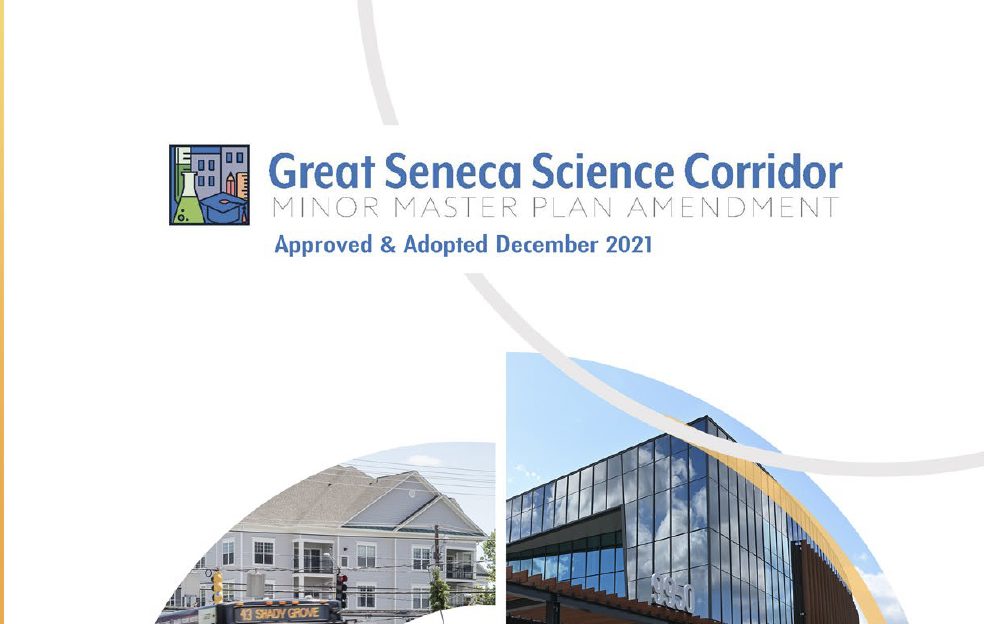
Great Seneca Science Corridor Minor Master Plan Amendment
Approved and Adopted December 2021
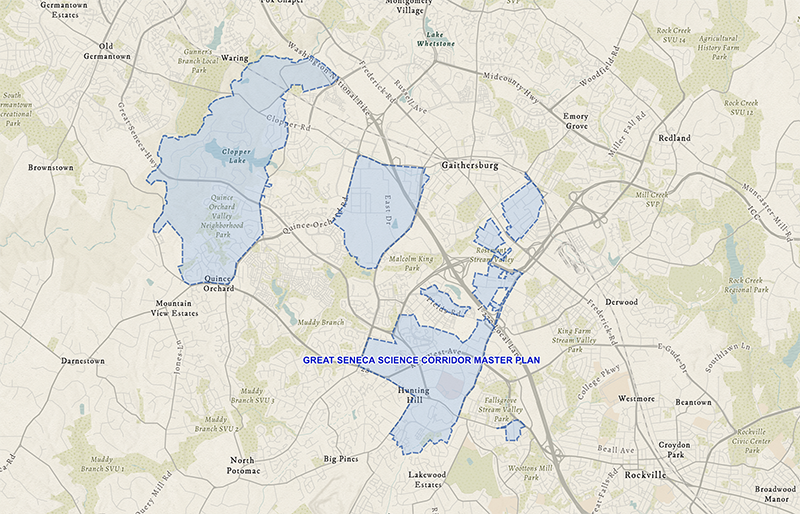
Plan Boundary

2010 GSSC Plan At-A-Glance

Plan context
Timeline

FAQs
Boundary
The Minor Master Plan will focus on the Shady Grove Life Science Center, outlined in red, even though the 2010 Greater Seneca Science Corridor Master Plan, shown in blue, includes a larger area. The Shady Grove Life Science Center serves as the county’s premier location for life science and biotech. Home to Shady Grove Adventist Hospital, Johns Hopkins University-Montgomery County Campus (JHU-MCC), the Universities at Shady Grove, biotechnology companies, and the National Cancer Institute’s consolidated headquarters are all located in the Life Sciences Center.
The planning area is completely or nearly completely surrounded by the City of Gaithersburg, the City of Rockville and the Town of Washington Grove. The City of Gaithersburg occupies 10 square miles in the center of the Plan area. These municipalities have their own planning departments, so while Montgomery Planning staff will coordinate with their municipal counterparts, areas within the municipalities are not included in the Plan boundary area.
2010 Great Seneca Science Corridor Plan At-A-Glance
The 2010 GSSC Plan established a vision and provided a blueprint to enable the Shady Grove Life Science Center to evolve into a vibrant live/work community and a globally recognized biotechnology hub. The 2010 envisioned a Shady Grove Life Sciences Center that:
- Includes first-class medical center, research facilities, academic institutions.
- Offers an array of services and amenities for residents, workers, and visitors.
- Provides an open space network that incorporates the area’s natural environmental features and connects destinations by paths and trails.
Is served by a fully integrated transit system that links Mid-County activity centers. View the 2010 Great Seneca Science Corridor Master Plan and the Life Science Center Monitoring Page.
Plan Context
In December 2019, the Montgomery County Council instructed Montgomery Planning to initiate a Minor Master Plan Amendment to the 2010 Great Seneca Science Corridor Master Plan (2010 Plan). The Minor Master Plan Amendment will examine the staging requirements of the 2010 Plan and offer potential amendments to the 2010 Plan.
Through the 2010 Plan, Montgomery County made an investment in transforming the Life Sciences Center (LSC) into a dynamic live/work community while ensuring growth opportunities for research, medical, and biotech interests. Through the 2010 Plan, we also made a commitment to preserve resident quality of life by enhancing community amenities and facilities and ensuring that growth does not overburden surrounding communities.
High quality transit is essential to achieving the vision of the 2010 Plan. However, the Corridor Cities Transitway (CCT), the nexus of the 2010 Plan, has not yet been funded and its future remains uncertain. Through Corridor Forward: The I-270 Transit Plan, Montgomery Planning is currently assessing transit options for communities along the I-270 corridor including the CCT. Corridor Forward will establish transit priorities and may recommend a change to the CCT, such as realignment, or may identify higher priority transit projects for communities along the I-270 corridor. Until the County Council approves Corridor Forward in Spring of 2022, the future of the CCT will remain uncertain.
Meanwhile, growth of biotech firms, medical laboratories, and healthcare institutions in the area is constrained by the 2010 Plan’s staging requirements as many of the requirements rely on the funding, construction and operation of the CCT. Commercial development cannot proceed, unless it was previously approved through the development review process. If capacity is not available for these companies and institutions to strengthen their Montgomery County roots, adding jobs and taxes to our economy, they may choose to go and grow elsewhere.
Economic impact is just one piece of the urgency around examining how the 2010 Plan stands up to and relates to current realities. The other is the importance of the life-changing work occurring in Shady Grove Life Sciences Center labs and healthcare facilities including cutting edge work to develop therapies for chronic and deadly diseases and care provided to community members facing illness. Perhaps most urgently, researchers and infectious disease experts in the Life Sciences Center are actively developing potential vaccines and treatments for Covid-19.
Changing realities and urgent Covid-19 needs lead Montgomery Planning to approach the Minor Master Plan Amendment in two phases, both aimed at adjusting for current realities and future trends.
Great Seneca Science Corridor Minor Master Plan Amendment Phases
First, Montgomery Planning will study and assess what aspects of the 2010 Plan were successfully implemented and which have not yet been realized. Then, we’ll recommend appropriate technical changes to modernize the staging requirements established in the 2010 Plan in response to current needs. The goal of the process and the resulting recommendations are to better serve the community while providing timely help for the life sciences industry to flourish and thrive now.
Any technical staging changes will balance additional commercial development proceeding with a public benefit, such as improved mobility options.
In 2022, Montgomery Planning staff will initiate another more comprehensive amendment process as we consider all of the recommendations from community feedback and our phase 1 assessment, the unique needs of companies and institutions in the life sciences industry, and the recommendations of Corridor Forward. Drawing on our evaluation of the growth, development, and infrastructure investment that has occurred in the Life Sciences Center over the last decade, we’ll identify and recommend strategies to advance progress toward the dynamic live-work community envisioned in the 2010 Plan. The comprehensive amendment will also look at zoning and other transportation elements and consider Vision Zero goals, racial equity and social justice, and guidance from Thrive Montgomery 2050.
Timeline
-
October 2020Scope of Work
-
October 2020 – March 2021Outreach, Analysis and Plan Development
-
April – July 2021Planning Board Review: Public Hearing and Work Sessions
-
August – September 2021County Executive Review of Planning Board Draft
-
October – December 2021County Council Review: Public Hearing and Work Sessions
-
January – March 2022Commission Adoption
-
February 2022Initiation of Phase Two: Great Seneca Science Corridor Minor Master Plan – a comprehensive update
-
March – May 2022*Corridor Forward Council Review
Frequently Asked Questions
will significantly transform land use, address the timing of development and the provision of key public facilities and amenities within the lifetime of a sector or master plan. Through staging requirements, incremental development is paired with infrastructure, public facilities, services or specific milestones to ensure that development advances at a pace consistent with the delivery of infrastructure and services necessary to support the development and minimize negative impacts.
The 2010 Plan applies staging requirements to the Shady Grove Life Sciences Center. Each development stage will be initiated when all of the triggers for that stage are met. After a stage has been triggered, individual properties can proceed with Preliminary Plan Approval—the first step in the development review process.
The 2010 Plan established a vision and provided a blueprint to enable the Life Sciences Center to evolve over time. Acknowledging that the Plan’s vision would take 25-35 years to develop, planners anticipated that future economic cycles and other factors made it imperative to periodically check the Plan’s progress and make necessary adjustments to achieve the vision.
The 2010 Plan also included staging requirements to ensure that growth and change in the LSC does not overburden the surrounding communities. These staging requirements are aimed at preserving residents’ quality of life by ensuring that growth is delivered and timed with the infrastructure necessary to support growth, especially transit.
The 2010 Plan includes four stages of development, with specific requirements at each stage. Many of the staging requirements in the early decades of the 2010 Plan implementation hinge on the funding, construction, and operation of the CCT before development can proceed. Since the State has not funded the CCT, much of the development planned for stages 1 and 2 cannot proceed.
Fortunately, the 2010 Plan acknowledged that realities and needs would change in future years and therefore mandated biennial and further periodic Plan check-ins to allow for needed adjustments. These check-ins provide an opportunity to uphold the Plan vision while adjusting for new and unanticipated realities like changes in transportation, economic trends, housing needs, and more.
The 2010 Plan established four stages of development, each with its own requirements and associated development capacity. The full staging plan can be found on page 76 of the 2010 Plan. The Life Sciences Center monitoring page also tracks the status of development staging in the area.
In June 2011, the Planning Board approved implementation guidelines for GSSC. These guidelines outline procedures for coordinating, staging, and monitoring implementation of recommendations for the Life Sciences Center. Among other things, the plan requires the creation of a biennial monitoring program to track development and staging triggers at each stage of the LSC’s development.
Visit our Life Sciences Center monitoring page to track the status of development staging in the area, including information on the LSC Loop Trail and Biennial Master Plan Monitoring Report.
